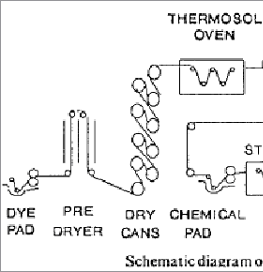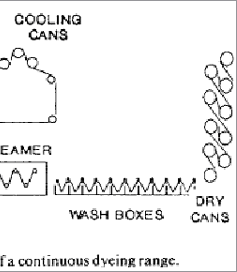The working of a continuous dyeing process is
described here. The textile substrates are feeded continuously into a
dye range. The speeds can vary between 50 to 250 meters per minute.
According to Industry estimates Continuous dyeing is a popular dyeing
method and accounts for around 60% of total yardage of the products that
are dyed.
A Continuous dyeing process typically consists the following. Dye
application, dye fixation with heat or chemicals and finally washing.
Continuous dyeing has been found to be most suitable for woven fabrics.
Mostly continuous dye ranges are designed for dyeing blends of polyester
and cotton. The step of padding plays a key role in the operation of
continuous dyeing. Sometimes Nylon carpets are also dyed in continuous
processes, but the design ranges for them is unlike that for flat
fabrics. Warps are also dyed in continuous process. Very good examples
of such warp dyeing are long chain warp dyeing and slasher dyeing using
indigo.
A continuous dye range has been found useful and economically
sustainable for dyeing long runs of a given shade. One important factor
that separates continuous dyeing from batch dyeing is the tolerance
factor for color variation. That is more for continuous dyeing as
compared to batch dyeing. This is so because of two reasons a) the speed
of the process. b) presence of a large number of process variables which
affects dye application. The process that is illustrated below is
designed for dyeing of blended fabric of polyester and cotton.
Some of the popular methods in continuous dyeing process are Pad-steam,
Wet-steam, thermosol dyeing, TAK dyeing, space dyeing, and pad-steam
dyeing long chain warp dyeing etc.
Continuous and to some extent semi-continuous dyeing
processes both are less prone to water consumption than batch dyeing,
but results in high concentration of residues. If some strict control
measures are taken up it is possible to reduce this losses of
concentrated liquor. The following steps may prove useful.
- Applying low add-on liquor application systems along with
minimising of volume capacity of the dip through when pad dyeing
techniques are in operation.
- Adoption of latest dispensing systems, where the chemicals get
dispensed on-line as separate streams. They gets mixed only at the
moment just before the delivery to the applicator.
- Using any of the following systems for dosing of the padding
liquor. Important to know that it should be strictly according to
the measurement of the pick up:
- A proper measurement of the dyeing liquor quantity
consumption in comparison to the processed fabric. The resulting
values thus obtained are processed automatically and applied in
preparing the next comparable batch.
- Application of the technique of rapid batch dyeing. Here the
dyestuff solution is prepared just in time, with steps that are
based on on-line measurement of the pick up. This proves better
than those dyestuff that is kept prepared already for the whole
batch before the commencement of the dyeing batch.
- To increase washing efficiency based on the proven principles
like reduction of carry-over and counter-current washing.



